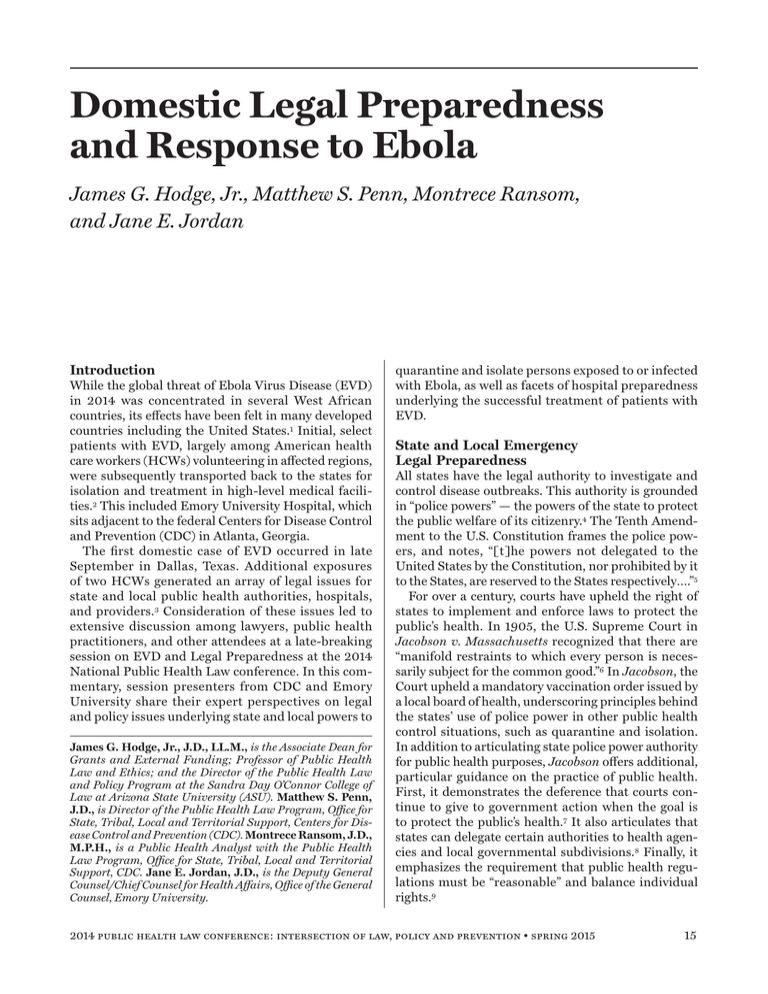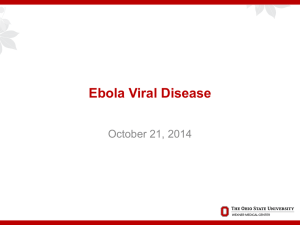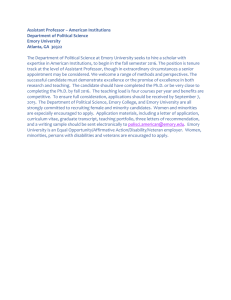Introduction
advertisement

Domestic Legal Preparedness and Response to Ebola James G. Hodge, Jr., Matthew S. Penn, Montrece Ransom, and Jane E. Jordan Introduction While the global threat of Ebola Virus Disease (EVD) in 2014 was concentrated in several West African countries, its effects have been felt in many developed countries including the United States.1 Initial, select patients with EVD, largely among American health care workers (HCWs) volunteering in affected regions, were subsequently transported back to the states for isolation and treatment in high-level medical facilities.2 This included Emory University Hospital, which sits adjacent to the federal Centers for Disease Control and Prevention (CDC) in Atlanta, Georgia. The first domestic case of EVD occurred in late September in Dallas, Texas. Additional exposures of two HCWs generated an array of legal issues for state and local public health authorities, hospitals, and providers.3 Consideration of these issues led to extensive discussion among lawyers, public health practitioners, and other attendees at a late-breaking session on EVD and Legal Preparedness at the 2014 National Public Health Law conference. In this commentary, session presenters from CDC and Emory University share their expert perspectives on legal and policy issues underlying state and local powers to James G. Hodge, Jr., J.D., LL.M., is the Associate Dean for Grants and External Funding; Professor of Public Health Law and Ethics; and the Director of the Public Health Law and Policy Program at the Sandra Day O’Connor College of Law at Arizona State University (ASU). Matthew S. Penn, J.D., is Director of the Public Health Law Program, Office for State, Tribal, Local and Territorial Support, Centers for Disease Control and Prevention (CDC). Montrece Ransom, J.D., M.P.H., is a Public Health Analyst with the Public Health Law Program, Office for State, Tribal, Local and Territorial Support, CDC. Jane E. Jordan, J.D., is the Deputy General Counsel/Chief Counsel for Health Affairs, Office of the General Counsel, Emory University. quarantine and isolate persons exposed to or infected with Ebola, as well as facets of hospital preparedness underlying the successful treatment of patients with EVD. State and Local Emergency Legal Preparedness All states have the legal authority to investigate and control disease outbreaks. This authority is grounded in “police powers” — the powers of the state to protect the public welfare of its citizenry.4 The Tenth Amendment to the U.S. Constitution frames the police powers, and notes, “[t]he powers not delegated to the United States by the Constitution, nor prohibited by it to the States, are reserved to the States respectively….”5 For over a century, courts have upheld the right of states to implement and enforce laws to protect the public’s health. In 1905, the U.S. Supreme Court in Jacobson v. Massachusetts recognized that there are “manifold restraints to which every person is necessarily subject for the common good.”6 In Jacobson, the Court upheld a mandatory vaccination order issued by a local board of health, underscoring principles behind the states’ use of police power in other public health control situations, such as quarantine and isolation. In addition to articulating state police power authority for public health purposes, Jacobson offers additional, particular guidance on the practice of public health. First, it demonstrates the deference that courts continue to give to government action when the goal is to protect the public’s health.7 It also articulates that states can delegate certain authorities to health agencies and local governmental subdivisions.8 Finally, it emphasizes the requirement that public health regulations must be “reasonable” and balance individual rights.9 2014 public health law conference: intersection of law, policy and prevention • spring 2015 15 JL ME SUPPLEMENT Isolation and Quarantine Powers Just as courts have upheld state authority to isolate and quarantine individuals, they have also historically upheld the requirement that such orders are reasonable. In 1900, the U.S. Circuit Court for the Northern District of California in Jew Ho v. Williamson overturned two San Francisco quarantine ordinances that tine.15 Variations in isolation quarantine laws and procedures demonstrate how health officials and their attorneys must familiarize themselves with their jurisdiction’s requirements for issuing orders, ensure that those requirements are met. The first domestic case of EVD occurred in late September in Dallas, Texas. Additional exposures of two HCWs generated an array of legal issues for state and local public health authorities, hospitals, and providers. Consideration of these issues led to extensive discussion among lawyers, public health practitioners, and other attendees at a late-breaking session on EVD and Legal Preparedness at the 2014 National Public Health Law conference. In this commentary, session presenters from CDC and Emory University share their expert perspectives on legal and policy issues underlying state and local powers to quarantine and isolate persons exposed to or infected with Ebola, as well as facets of hospital preparedness underlying the successful treatment of patients with EVD. were passed to control an alleged outbreak of the bubonic plague.10 The court found that the quarantine as established was “unreasonable, unjust, and oppressive” because it included homes occupied by Chinese individuals, and specifically “left out certain persons, members of races other than Chinese.”11 The requirement that quarantines be reasonable was most recently seen in Mayhew v. Hickox,12 in which a local district court in Maine rejected an order to quarantine a nurse who was EVD asymptomatic. While states may exercise broad police powers to protect the public’s health, such actions must be reasonable and justified to survive judicial challenge. Procedural Requirements When an outbreak scenario, such as EVD, calls for isolation or quarantine, the legal issues are not limited to the nature and scope of legal authority. Government’s power to engage in disease control activities must be balanced with due process rights of affected individuals. As well, isolation or quarantine should be implemented in the least restrictive way necessary to maintain public health.13 While many state laws do not spell out the procedures for quarantine and isolation, others have fairly detailed provisions14 derived mostly from constitutional due process requirements. Generally, these include the right to (1) notice, (2) counsel, (3) a hearing, and (4) a rational/reasonable basis for isolation or quaran16 Hospital Preparedness: Emory Case Study The successful admission, treatment, and discharge of four EVD patients at Emory University Hospital during the late summer and early fall of 2014 were the combined result of timely clinical care, adherence to the highest levels of safety, a skilled care team, and perhaps most importantly, 12 years of planning and practice, including biannual preparedness drills. Emory’s Special Containment Disease Unit (SCDU) and its associated dedicated care team were established more than a decade ago to provide local health care capacity to support the CDC’s research on the world’s most serious communicable diseases. Concurrent with the creation of the SCDU, Emory established an enterprise-wide program, the Office of Critical Event Preparedness and Response (CEPAR),16 committed to a coordinated emergency response to disease, natural disaster, or other causes. Collectively, the SCDU, the clinical care team, and the CEPAR operation were critical to Emory’s ability to treat these patients. These comments will not address the issue of clinical preparedness, except to note that even Emory’s highly trained clinical care team must “expect the unexpected.”17 Preparedness also requires that a larger comprehensive team be ready to address non-clinical issues that invariably arise in any emergent situation. While the specific composition of this larger team varies depending on the situation, certain non-clinical competencies are required, including: journal of law, medicine & ethics Hodge, Jr., Penn, Ransom, and Jordan • Public Relations/Communications/Crisis Management; • Risk Management; • Security/Facilities Management/Transportation; • Environmental Safety; • Compliance/Privacy; • Legal Considerations; • Customer Service/Patient Relations/Pastoral Care; and • Human Resources Assembling a “preparedness team” before an emergency occurs is important to prevent loss of valuable time spent finding, identifying, and assembling the right personnel. Once the team is in place and an exigent situation presents, multiple practical issues must be addressed, including: • Agreements on external messaging and identification of a spokesperson with substantive knowledge and who engenders trust of employees and the public. Emory’s visible spokespersons were clinicians and care providers (although senior administration was involved and supportive as well). External messages were clear, simple, and intended to address the public’s anxiety (“We can fear, or we can care”); • Proactivity with educating the media about medical facts consistent with protecting patient confidentiality; • Effective coordination with external partners in the community; and • Communications strategy and timing/notice to internal governance. Legal preparation was also key. Emory’s team was trained in compliance issues underlying the HIPAA Privacy Rule18 and EMTALA;19 informed consents (general and research); and principles of federal and state rights concerning quarantine and isolation. Still, legal and ethical questions arose in multiple areas, such as ensuring the safety of employees; hospital capacity constraints; determinations as to when some treatments for specific patients may be futile; and drafting contracts to meet specific situations (e.g., hazardous waste removal). In sum, preparedness — clinical, legal, and administrative — prior to the patients’ arrival is critical to successful outcomes. Involving sometimes disparate operational units toward a common goal is also essential. Emory’s motto, “We’re All in This Together,” accurately describes these joint efforts in the unique clinical situation surrounding the treatment of EVD patients. Disclaimer and Acknowledgment The findings and conclusions in this publication are those of the authors and do not necessarily represent the official position of CDC, the Robert Wood Johnson Foundation, or Emory University. This article should not be construed as providing legal guidance or advice. The authors acknowledge the contributions of Gregory Sunshine, J.D., Oak Ridge Institute for Science and Education (ORISE) fellow with the Public Health Law Program, Office for State, Tribal, Local and Territorial Support, CDC; Ryan Morhard, J.D., Branch Chief – International Partnerships, Division of International Health Security, Office of the Assistant Secretary for Preparedness and Response, U.S. Department of Health and Human Services; and Greg Measer, Asha Agrawal, and Matt Saria, Public Health Law and Policy Program, Sandra Day O’Connor College of Law, ASU. References 1. L . O. Gostin, J. G. Hodge, Jr., and S. Burris, “Is the United States Prepared for Ebola?” JAMA E1–2 (2014), available at <http:// jama.jamanetwork.com/article.aspx?articleid=1918850> (last visited January 13, 2015). 2.J. G. Hodge, Jr., L. O. Gostin, D. Hanfling, and J. L. Hick, “Law, Medicine, and Public Health Preparedness: The Case of Ebola,” Public Health Reports, 130 (2014): 1-4, at 2. 3.J. G. Hodge, Jr., G. Measer, and A. M. Agrawal, “Top 10 Issues of Law, Public Health, and Ebola,” ABA Health e-Source 2015. 4.F. E. Shaw, K. L. McKie, C. A. Liveoak, R. A. Goodman, and the State Public Health Counsel Review Team, “Variation in Quarantine Powers Among the 10 Most Populous US States in 2004,” American Journal of Public Health, 97 no. S1 (2007): S38-S43, at S38. 5.U.S. Const. Amend. X. 6. Jacobson v. Massachusetts, 197 U.S. 11, 26 (1905). 7. Id., at 27 (“Upon the principle of self-defense, of paramount necessity, a community has the right to protect itself against an epidemic of disease which threatens the safety of its members.”). 8. Id., at 25 (“It is equally true that the state may invest local bodies called into existence for purposes of local administration with authority in some appropriate way to safeguard the public health and the public safety. The mode or manner in which those results are to be accomplished is within the discretion of the state, subject, of course, so far as Federal power is concerned, only to the condition that no rule prescribed by a state, nor any regulation adopted by a local governmental agency acting under the sanction of state legislation, shall contravene the Constitution of the United States, nor infringe any right granted or secured by that instrument.”). 9. Id., at 29 (“But it is equally true that in every well-ordered society charged with the duty of conserving the safety of its members the rights of the individual in respect of his liberty may at times, under the pressure of great dangers, be subjected to such restraint, to be enforced by reasonable regulations, as the safety of the general public may demand.”). 10. Jew Ho v. Williamson, 103 F. Supp.10 (C.C.N.D. Cal. 1900). 11. Id., at 24. Additionally, the court questioned whether the bubonic plague was at all present, as no living cases had been examined and there had been no evidence of “transmission of the disease from any of those who have died.” Id., at 25. Ultimately, the court stated “the evidence in this case seems to be sufficient to establish the fact that the bubonic plague has not existed, and does not now exist, in San Francisco.” Id., at 26. 12. Mayhew v. Hickox, No. CV-2014-36 (D. Maine October 31, 2014) (order pending hearing), available at <http://courts. maine.gov/news_reference/high_profile/hickox/order_pending_hearing.pdf> (last visited January 13, 2015). 2014 public health law conference: intersection of law, policy and prevention • spring 2015 17 JL ME SUPPLEMENT 13. Shelton v. Tucker, 364 U.S. 479, 488 (1960) (“In a series of decisions this Court has held that, even though the governmental purpose be legitimate and substantial, that purpose cannot be pursued by means that broadly stifle fundamental personal liberties when the end can be more narrowly achieved. The breadth of legislative abridgment must be viewed in the light of less drastic means for achieving the same basic purpose.”). 14.See Shaw et al., supra note 4. 15.See 20 Ill. Comp. Stat. Ann. 2305/2(c) (West 2014). 16.Emory University, CEPAR Office of Critical Event Preparedness and Response, available at <www.emergency.emory.edu> (last visited January 13, 2015) (CEPAR is the Center for Emory enterprise-side planning for, and coordinated response to, catastrophic events affecting Emory and the broader community. It partners with various schools, departments, organizations, 18 groups and governing bodies throughout the institution and the community). 17.A. Isakov, A. Jamison, W. Miles, and B. Ribner, “Safe Management of Patients with Serious Communicable Diseases: Recent Experience with Ebola Virus,” Annals Internal Medicine (2014), available at <http://annals.org/article. aspx?articleid=1906849> (last visited January 13, 2015); J. Fox, B. Bornstein, and S. Grant, “Emory Healthcare Ebola Preparedness Protocols,” available at <www.emoryhealthcare.org/ ebolaprep> (last visited January 13, 2015) (for a compilation of Emory’s protocols and external resources used in the treatment of patients with Ebola). 18.45 C.F.R. § 160.100 et seq. 19.42 U.S.C. §1395dd (2011). journal of law, medicine & ethics


